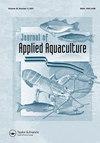Effect of Bacillus spp. on the composition of gut microbiota in early life stages of Indian white shrimp, Penaeus indicus
IF 0.8
Q3 FISHERIES
引用次数: 5
Abstract
ABSTRACT To study the effects of the probiotics on the gut microbial community of Penaeus indicus larvae, a combination of three probiotics—Bacillus subtilis, B. lichiniformis, and B. pumilus (5 × 1010 cfu/gram)—were added to the rearing environment of shrimp larvae (5,000/500 L). Altered microbial communities due to the application of probiotics were studied using 16S rRNA-based Illumina sequencing. The results suggest that the probiotics-treated group showed higher richness; the control group was even as measured by alpha diversity indices. The abundance of Proteobacteria was higher in the probiotic-treated group (94.85%) compared to the control (58.29%). At the genus level, the probiotics group was dominated by Vibrio (44.17%), Rhodobacteraceae_unclassified (25.22%), Catenococcus (12.89%), Pseudoalteromonas (4.76%), and Kordia (1.53%); Tenacibaculum (24.29%), Catenococcus (19.38%), Vibrio (7%), Gammaproteobacteria_unclassified (6.6%), Fluviicola (5.91%), and Chlamydiales_unclassified (4.61%) dominated in the control group. Results indicate that probiotic application influenced the taxonomic profile of gut microbes. This information helps us to understand the effect of probiotic application especially in penaeid shrimp hatcheries.芽孢杆菌对印度对虾早期肠道微生物群组成的影响
摘要为了研究益生菌对印度对虾幼体肠道微生物群落的影响,将枯草芽孢杆菌、地衣芽孢杆菌和短小芽孢杆菌(5×1010cfu/g)三种益生菌的组合添加到对虾幼体(5000/500L)的饲养环境中。使用基于16S rRNA的Illumina测序研究了由于应用益生菌而改变的微生物群落。结果表明,益生菌处理组表现出较高的丰富度;对照组甚至与阿尔法多样性指数一样。益生菌处理组的变形菌丰度(94.85%)高于对照组(58.29%)。在属水平上,益生菌组以弧菌(44.17%)、红细菌门(25.22%)、Catenococcus(12.89%)、假交替单胞菌(4.76%)和Kordia(1.53%)为主;Tenacibaculum(24.29%)、Catenococcus(19.38%)、Vibrio(7%)、Gammaproteobacteria未分类(6.6%)、Fluviicola(5.91%)和Chlamydiales_未分类(4.61%)在对照组中占主导地位。结果表明,益生菌的应用影响了肠道微生物的分类特征。这些信息有助于我们了解益生菌的应用效果,尤其是在对虾孵化场。
本文章由计算机程序翻译,如有差异,请以英文原文为准。
求助全文
约1分钟内获得全文
求助全文
来源期刊

Journal of Applied Aquaculture
Environmental Science-Ecology
CiteScore
3.20
自引率
0.00%
发文量
38
期刊介绍:
The Journal of Applied Aquaculture is a platform for the sharing of practical information needed by researchers to meet the needs of investors, farm managers, extension agents and policy makers working to adapt aquaculture theory to achieve economic and food security objectives in the real world. The journal emphasizes multi-disciplinary research and case studies that propose financially and logistically viable solutions to observable problems.
 求助内容:
求助内容: 应助结果提醒方式:
应助结果提醒方式:


